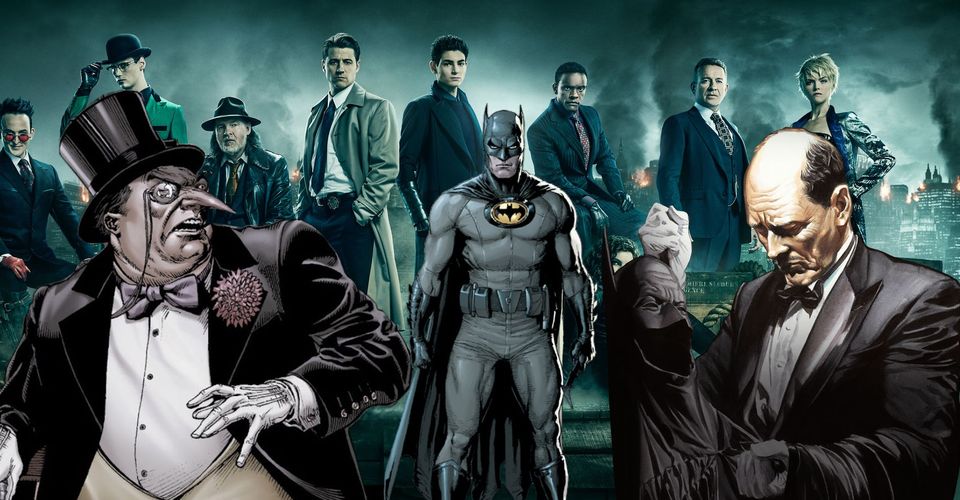Gotham Became A Comic Accurate Batman Show (Eventually)

It may have taken a while, but Gotham eventually became something close to a comic accurate Batman series in its final season. Throughout its five season run, Gotham has made no bones about deviating from established canon. Whether it’s Bane and Jim Gordon being old pals, Penguin having a romantic interest in the Riddler, or the show’s unique interpretation of Joker, Gotham took a loose approach to adapting its source material.
More often than not, these changes worked to Gotham‘s advantage, or were at least understandable, and usually helped to bring familiar Batman stories and characters into the show’s pre-Batman setting. However, the inherent problem with prequels is that viewers know exactly where the story and its characters will wind up come the end of the final episode, and anything that appears to contradict that could fall afoul of fan opinion.
As such, not all of Gotham‘s changes to Batman canon were well-received and there were certainly times when it seemed as if the show might have been building towards a radically different interpretation of the superhero’s story. That was until the penultimate episode of season 5, which made a huge effort to drag the landscape of Gotham towards something resembling comic accuracy. Here’s how it happened.
- This Page: Jim Gordon and Bruce Wayne
- Page 2: Alfred, Selina, Penguin, and Riddler
Jim Gordon

From the very first episode, it always seemed likely that Gotham would conclude with Jim Gordon finally attaining the rank of Commissioner, and that prediction finally came to pass in the show’s penultimate episode. In most Batman material, Gordon is presented as Batman’s police Commissioner ally and this promotion sets up that future relationship and establishes Jim as the police chief fans are familiar with from the comics and movies.
On a more personal level, the episode also succeeded in resolving Gotham‘s Batgirl issue. In the comics, Jim’s daughter Barbara goes on to become the famous female vigilante who works alongside Batman and Robin, but Gotham threw viewers an early curveball when Jim and Barbara’s mother (confusingly also called Barbara) ended their relationship. Fans were left wondering whether the show would give Batgirl a different mother or even if they’d omit her existence entirely, but a one night stand between Jim and Barbara Kean in season 5 resolved those worries, producing a baby girl 9 months (or 6 episodes, as it turned out) later.
Gotham‘s penultimate episode ultimately confirms that Jim’s baby would be named after its mother – thus setting up the infant as the future Batgirl. Now all Jim needs is the mustache.
Bruce Wayne

With his transformation into Batman due at any moment, Bruce Wayne arguably needed even more development in Gotham‘s final episodes than Jim Gordon. With a mere two installments left, the future Dark Knight still had no obvious connection to bats and no reason to start working as an outlaw, given that Bruce has spent the entirety of season 5 working well alongside Jim Gordon and the GCPD.
These points have now been addressed to some extent. “They Did What?” saw Lucius Fox provide Bruce with a device hampered by one unfortunate defect – it made a noise that summoned droves of “certain winged mammals” towards the user. In a later scrap against the mighty Bane, young Bruce deploys his new toy and the villain is overcome by a swarm of bats, as Bruce looks on in contemplative foreshadowing. This hardly explains why Bruce might suddenly decide to weave a bat design throughout his entire wardrobe, but combined with the vision he experienced in season 4 (the only other notable appearance of bats in Gotham), it perhaps does at least offer some reasoning behind the connection. Interestingly, Lucius also arms Bruce with EMPs, smoke grenades and other accessories that will later become staples of the Bat-arsenal.
The same episode also approached the issue of Bruce working as a vigilante. The threat of Bane and Nyssa al Ghul is eventually nullified when the heroes, villains and residents of Gotham City unite and stand against their assailants. The message is one of strength in togetherness. Obviously, this is completely at odds with Bruce’s future working as a lone outlaw. Thankfully, his stance is explained when, as Gotham celebrates an unlikely victory, Bruce quietly broods over whether his status as a young and outspoken billionaire contributed to the city’s woes. This subtly plants the seeds for a future where Bruce resolves to fight crime alone with a mask and a secret identity.
About The Author


















